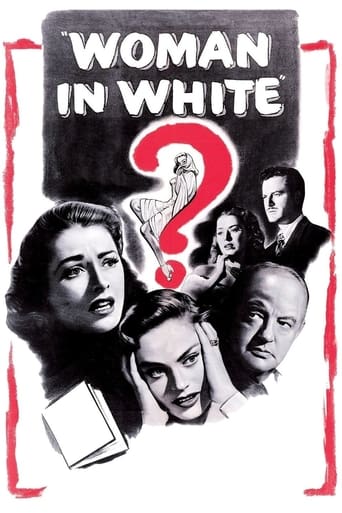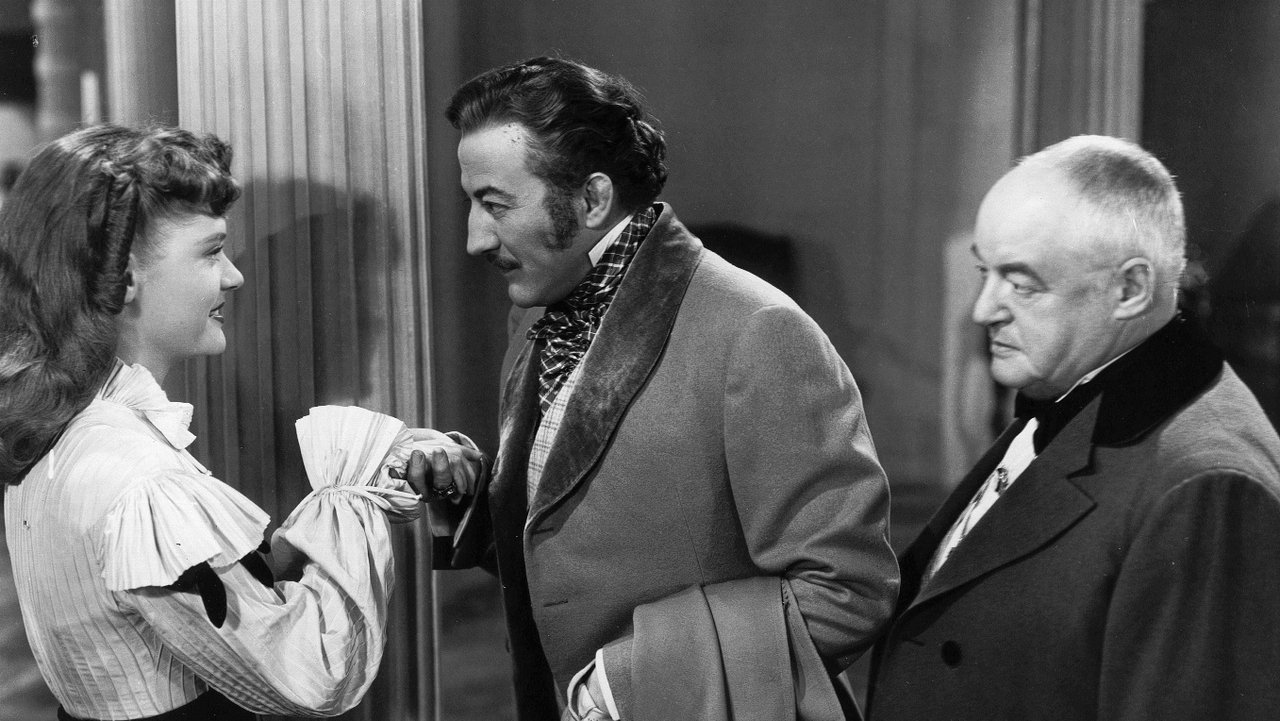clanciai
Although none of the screenings of this famous thriller novel for television or for film have been too faithful to the novel, which is actually related in different versions by the characters themselves, which makes it very complicated and sophisticated, it's impossible to make a bad screening of it, no matter how much you shorten it. This is the most shortened version of all, while the 1982 version is the most faithful and best. However, none of the other Foscos are so true to the original character as Sidney Greenstreet here, who awesomely dominates the film. Eleanor Parker is excellent in her double role as both Laura and Anne Catherick, but she is a bit too beautiful for Laura, while her rendering of Anne Catherick is better - they actually become like one in the end. Alexis Smith plays with style as usual, and it's impossible for any actress to fail with a character like Marion Halcombe. The Sir Percy Glyde dandy figure is also good but is whisked away in this rather mutilated version. Gig Young as Walter is the only one who does not quite fit in.Other excellent merits of this film is the marvellous score of Max Steiner with harp for the dominating instrument - none of the other versions make a success of the music. The black and white photography also adds to the eerie and moody blues of this horror story of wicked intrigue, and although the finale of the novel is ignored here, Agnes Moorehead as the countess Fosco instead gets something to do - here she is made to combine both the countess and Mrs Catherick in the novel.So although much of the novel, and especially its highlights, are lost in this film, it definitely has deserts enough to vie with the other later versions in colour, which have other advantages over this one.
mcannady1
First, just a few words about the original version of the film. The beautiful, sensitive music by Max Steiner, the all-star cast, and fantastic photography of London locales combined make the film well-worth watching. To all this we have the romance of the story which is quite enlivened by underlying evil of some of the key characters.However, some of the important events are quite different in the novel. If we view the superb adaptation of the 1982 version with Alan Badel and Diana Quick, we will ultimately see the true story in pretty much its entirety. The ending that puzzles us in the 40s version is resolved once we see the newer version or read the novel.We still have a happy ending per see, but it is the one intended by the author and reasonably derived from the story in the film.I think the reason they changed the punch-line and Walter married the wrong girl, is because Laura's half=sister Marian has worked tirelessly to help her sister. Yes, we would love her to get together with Walter. However, it is best to re-unite Walter with Laura, as they had realized their love for each other early in the story. She only marries Sir Percival because her father had wanted her to do so. Soon she discovers that he is cruel and conniving. At the time their house guests, Count and Countess Fosco appear to be friends.Complicating matters further, we see The Count making overtures to Marian Halcomb, and even writing in her diary about his feelings when she is sick with fever.Coincidentally, I have been re-reading the novel by Wilkie Collins and find it very unique. Not only is the book rather lengthy, the story is told by different character's perceptions. It is like a recipe for a cake or a favorite dinner dish. WHen we put together all of the characters and their story of what had taken place, we zoom in on the real events. Ultimately we see revealed the conspiracy that dupes innocent pawn, Ann Catherick, and the innocent heiress, Laura Fairlie. Both girls are treated badly for the purpose of financial gain.Ann had hoped to meet Laura and speak to her of Sir Percival's evil secret. Laura had left home, thinking her half-sister Merian, would be at the Count's home. So both girls believe they will meet with each other.The most evil character, Count Fosco, appears to be kind and chivalrous, while assisting his friend, Sir Percival Glyde, in receiving his wife's 30 thousand pounds at her death. Under his mask of kindness, The Count tricks Ann CAtherick into thinking she will meet with Laura Fairlie on an important matter. She had recently escaped from a mental asylum, having been unfairly committed by Sir Percival Glyde, who fears she knows his secret. At the time his plans begin to fail, as he does not know Ann has a serious heart condition. Concurrently, he switches her identity with Laura Fairlie; returning Laura to the asylum under Ann's name.Having switched both girls, The Count is ready to help his friend, Sir Percival Glyde, to receive the money prematurely. Sir Percival, rude and unkind to his wife Laura, is ready to receive his friend's help, no matter how it works out. The diabolical nobleman dies in a fire in the church which might have revealed in its registers that he should not have the title or the money he presently has.After "Lady Glyde" has died, Walter Hartwright the drawing master who loves her, returns and begins to work out details of the conspiracy. He finds Laura at the cemetery and realized that Ann has been buried mistakenly as Lady Glyde, He and Marian, Laura's half-sister, assist in discovering the true scheme, unaided by Laura's uncle who believes Count Fosco and his wife who assert that she is dead. He is selfish and indolent, staying calm at all costs. Walter realizes that Laura needs to be recognized in her true identity, as Mr. Fairlie will not let her in the house with Marian. Thus, she will not have her status or her money. Walter and Marian work tirelessly to discover the scheme, interview witnesses, and seek legal aid. At the same time, they discover that Laura has memory blocks about her time in the asylum So, with all that said, both versions are well-worth watching, and so is the novel to be read.For anyone who has not seen Alan Badel's fabulous 1982 performance as The Count, it is quite a treat. Also, as was stated in other reviews, the wonderful Sydney Greenstreet as Count Fosco, and Agnes Morehead is also superb as Countess Fosco. A last few words is giving merit to the wonderful Eleanor Parker in the dual role in the film. She is great as the lovely Laura Fairlie and as The Woman in White.My score for the 1982 version is a 10. For the 1947 version, I score a 7, as two very important aspects of the story are changed toward the ending.
utgard14
Nice old Warner Bros Gothic mystery, aided by a solid cast. As many other reviewers here point out, Sydney Greenstreet is terrific. He carries the weight of the movie (no pun intended) even during the slow stretches. The rest of the cast is good, although Gig Young is perhaps miscast. Agnes Moorehead has a small but memorable role and John Abbott had me in stitches in all of his scenes.Having not read the novel upon which the movie is based, I cannot comment on how faithful this film is. However, judging the film's story by itself, it's an enjoyable but not terribly surprising mystery. A little stuffy at times, no doubt impacted by Gig Young's somewhat wooden performance. If you're interested in Gothic mysteries, give it a shot.
tedg
I urge you to see this for historical reasons.The dominant shapes of narrative we have are governed by the detective story. Like most of the abstract structures we use -- and treat as if the world really was made that way -- are recent. This huge shape can be traced in film but if first appeared in literature, with mister Collins.We would not have a recognizable detective for a few iterations. There are still remnants of the Dickensian model where peculiar characters shape the world. Mister Fairlie here, an absurdly nervous effete and his meek assistant are from that model. The intrigue as well: a family fortune complexly entailed.But the notion of an outside observer who is on screen, structuring the narrative from observations we share is new. Our "detective" is a professional observer, a painter. This profession was the closest that then existed to the qualities we need.What we would now consider part of the detective duties -- being an on screen observer in addition to sensemaker -- is shared by the love of the painter. Here the role is played by a heartbreakingly lovely earnest actress. The stock is black and white but we know she is redheaded.Cinematically, they have missed the opportunity to leverage the process of logical assembly that goes on in the mind of the artist. That would have been profoundly cinematic. The specific inadequacy of this film is what inspired Greenaway with "Draughtsman" which you might watch with this.The cinematic carrying is done here by Greenstreet. His device is that he has the ability to hypnotize. It is women-only and apparently intuitive. The filmmaker does well enough with this.You won't find this to be a very good film. But it is an accurate enough version of the book. And that started something that every film student needs to understand.Ted's Evaluation -- 3 of 3: Worth watching.


 AD
AD



